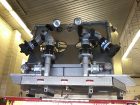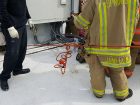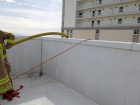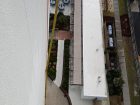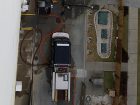
Features
Structural
Training
Back to Basics: February 2017
We have come to the fifth part of our series on standpipes. So far, we have looked at using standpipes within buildings, either wet or dry standpipes. But what happens when the provided standpipe will not or does not work when we need it?
February 7, 2017
By
Mark van
History has taught us that this what-if situation has happened with disastrous consequences.
■ Standpipe failure
On Feb. 23, 1991, the One Meridian Plaza office tower in Philadelphia produced a fire that resulted in the deaths of three firefighters and gutted eight floors before crews could bring the fire under control. The standpipe system failed to work, adequately resulting in the Philadelphia Fire Department crews creating their own standpipe.
As far-fetched as this thought or idea may sound, it is your only solution when facing a fire of any size in any high/low-rise or standpipe-equipped building. What may cause a standpipe to fail?
- Lack of maintenance
- A build up of corrosion or sediment
- Lack of annual testing/inspection to ensure proper operation
- Improperly set pressure-reducing valves
- Blocked pipes/valves
Regardless of the reason for the standpipe failure, firefighters need to overcome the problem, and quickly. So how do we do this?
At One Meridian Plaza, Philadelphia firefighters created their standpipe after other tactical efforts were tried and exhausted; they accomplished this by stretching three five-inch (125 millimetre) large-diameter hoselines vertically in the stairwells from the ground floor up to the 24th floor.
This example required a tremendous amount of manpower, but each incident is different. What else can firefighters do to find a solution for this “what if” question?
■ AERIAL option
One option is to use an aerial. Photo 1 shows that an aerial can be quickly converted into a manual standpipe system. With the platform type of aerial, firefighters can have one or two connections ready for hook up to a hoseline. Whether you are using a 1 ½- inch (38 mm), 1 ¾-inch (45 mm) or a 2 ½-inch (65 mm) hoseline, the platform can provide the connection. If access to a straight stick or ladder is all that you have, the same thing can be done by removing the nozzle tip from off the pipe connection and threading on your hoseline.
The only problem using an aerial is the height limitation based upon the reach of the aerial. Incidents that require a reach of more than 10 storeys require another solution.
■ Supply-line option
The other option (adopted from FDNY) is to create a standpipe by lowering a supply line from the floor below the fire floor to the engine or pumper outside. This makeshift standpipe will be placed over a balcony or through a window, using a piece of life-safety rope, sections of 2 ½-inch hose, and a piece of webbing. Each section of 50-foot (15-metre) hose will cover five storeys. So, for a fire on the 14th floor, firefighters would need three sections of hose to make a standpipe.
Once these items have been brought up to the staging floor, the first step is to secure an anchor point.
The anchor point will be determined based on what is available in the immediate area.
Photo 2 (on page 36) shows an example of such an anchor point being used for a roof operation.
Once the anchor point has been decided upon, the second step is to secure the other end of the rope around one of the sections of hose that will be lowered down by tying a variety of different hitches around the hose.
The first section of hose going over the side will need to be the tied with a piece of webbing around the female coupling end; this piece of webbing allows the pump operator to grab or secure the hose from above before it hits the ground, and guide the hose to the pump panel or discharge outlet. Photo 5 shows the lime-green webbing on the ground where the hose was lowered down.
As the hose is lowered to the ground, the third or fourth section of hose will have the life safety rope tied around it so that it will be secured and kept from fall to the ground. Photo 3 shows taut rope securing the hose vertically; photo 4 shows the hitch knot tied around the hose, keeping the supply line vertical.
Once the hose has been put into place, the pump operator can charge the line with water and send it up with the correct pressure required to supply the hand line being used for fire suppression efforts.
On the end of the supply line can be placed at a gate valve so that firefighters can control the water supply.
Mark van der Feyst has been in the fire service since 1999 and is a full-time firefighter in Ontario. Mark teaches in Canada, the United States, and India. He is a local level suppression instructor for the Pennsylvania State Fire Academy and an instructor for the Justice Institute of BC. He is also the lead author of Pennwell’s Residential Fire Rescue book. Mark@FireStarTraining.com
Print this page
